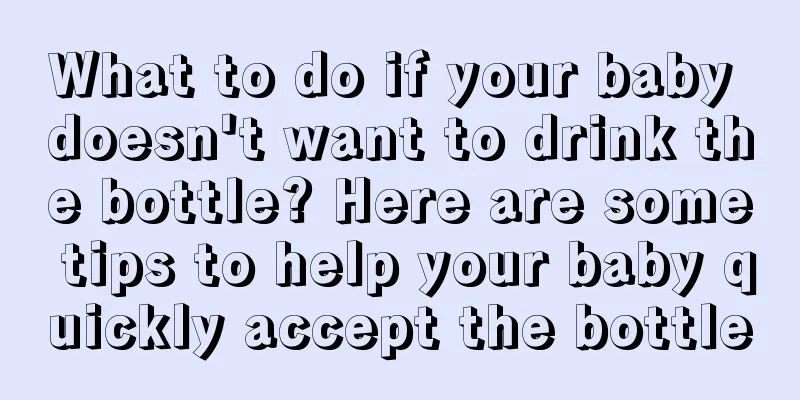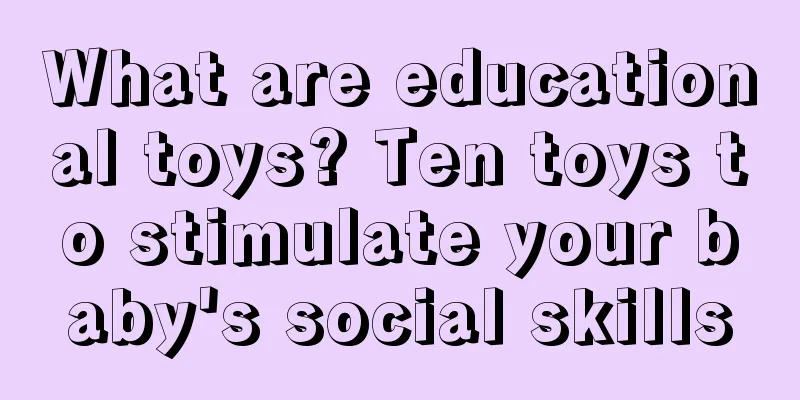What to do if your baby doesn't want to drink the bottle? Here are some tips to help your baby quickly accept the bottle

|
Babies who drink breast milk are reluctant to drink from bottles, but if you want to wean your baby, you have to let the baby accept the bottle first. This makes new parents very embarrassed. What should you do if the baby just doesn't want to drink from the bottle? How can you make your baby accept the bottle quickly? Here are some tips for you. What to do if your baby refuses to take a bottle1. Choose the right pacifier Although the feeling of a good pacifier and breastfeeding will still be different, you can choose a pacifier that is closer. Mothers should change pacifiers in time according to the age of their babies to prevent the pacifier from being too small, which makes it more difficult for the baby to suck and the baby to feel bored. Mothers can test whether the baby does not like the pacifier or the taste of milk powder. Try to squeeze out breast milk and feed it to the baby in a bottle. If he accepts it, he may not like the taste of milk powder. You can try a brand that tastes closer to breast milk. In addition, you can try to make the milk powder lighter or colder or hotter. Different pacifiers should be used for different things for the baby to drink. For example, if the baby drinks juice, you should prepare a special juice pacifier so that the baby can drink juice more smoothly. 2. Make the nipple bigger The mother can use a sterile needle to poke a larger hole in the nipple to ensure that the flow rate is greater than that of breast milk. This measure is very effective for babies who cry when the nipple is in their mouths, because it can make her feel that the milk can flow out very smoothly. Remember to let the baby sit upright on your lap to avoid the child choking or panicking due to excessive flow. Do not let the baby lie in your arms as when breastfeeding, as this position is uncomfortable for the baby when feeding with a bottle. If the baby shows signs of choking, let him stand upright immediately, but keep the nipple in his mouth. 3. Hunger leads to appetite It is said that babies will eat when they are hungry, but it is not good to keep them hungry all the time, and some stubborn babies would rather be hungry than eat. You can let them be a little hungry, and do not give them anything to eat or drink for at least two to three hours before giving them a bottle, until they feel hungry and have an appetite, and they will naturally eat when they are hungry. 4. Attract attention Mothers can put cute cartoon patterns on the bottle to attract the baby's interest in the bottle. Or use toys or TVs that make noises to divert the baby's attention. Before the baby realizes that the pacifier is in his mouth, he has already started sucking unconsciously. 5. Let someone else feed your baby the first bottle of milk If the mother feeds the baby with a bottle, the baby will be confused and wonder why the mother does not let him feed directly from the nipple like before. Therefore, the mother can let others feed the baby with a bottle when you are not around, so that the baby is more likely to accept drinking milk from a bottle. It is best for the mother to leave the house when the baby drinks the first bottle of milk, because even if the mother is in the next room, the baby can smell the smell on her body, which will not be effective. Reasons why babies don't drink bottles1. Don’t like hard nipples. This can be divided into two aspects: one is the material of the nipple, and the other is the size of the nipple hole. If the baby’s sense of touch is sensitive, it is easy to detect the hardness of the nipple. Once the nipple is hard and obviously different from the mother’s nipple, when the mother feeds the baby again, the baby will naturally resist and will not eat the bottle. This is also a common situation. Similarly, the size of the nipple hole plays an important role in whether the baby can drink milk comfortably. A nipple that is too large or too small will make the baby uncomfortable when drinking milk, which will cause the baby to refuse the bottle. 2. Don’t like the taste of milk powder. If the baby doesn’t like the milk powder when it is put in the bottle, but likes the breast milk when it is put in the bottle. This means that the baby doesn’t like the taste of the milk powder. It is recommended that the mother choose another formula milk powder that tastes close to breast milk. 3. The baby is in the milk aversion period. Milk aversion is a common phenomenon in the growth of babies. Once the baby is in the milk aversion period, whether it is breast milk or formula milk or other dairy products, the baby will refuse it, and naturally will also resist the bottle. During this period, if the baby does not like to eat the bottle, it is normal, and mothers do not need to be anxious. After this stage, the baby's refusal to eat the bottle will improve. 4. Babies start to be spoiled. As they grow older, they gradually establish their own "worldview" and have their own understanding of the external environment. It is normal for them to occasionally get upset. At this time, mothers should guide their children in a principled way, not just thinking about coaxing their children, and certainly not spoiling them. Excessive pacifier useOf course, this method is suitable for babies who do not accept pacifiers or bottles! You can try to get your baby to accept the pacifier first. You can use the pacifier as a toy for your baby and let her suck the pacifier herself. After she accepts the pacifier, continue to try to get her to accept the bottle. This will increase the chance of success! It is recommended not to buy a pacifier that is very different from a breast milk nipple. Try to buy a pacifier that is similar to the nipple. The most basic pacifier from Avent is recommended. How to bottle feed1. Before feeding your baby with a bottle, wash your hands first, take out the sterilized bottle and nipple, and be careful not to place the nipple randomly, but keep it upright and do not dirty it. Pour the prepared milk into the bottle and tighten the cap. Tilt the bottle and drop a few drops of milk on the back of your hand to test the temperature. It should be neither too fast nor too slow. The milk should drip at a moderate speed. 2. Choose a comfortable sitting position and sit firmly. Hold the baby in one hand, let the baby's upper body lean on the mother's elbow, and support the baby's hips with the mother's arm, so that the baby's whole body is tilted about 45 degrees; hold the bottle in the other hand, touch the baby's lips with the nipple, he will open his mouth and start sucking. 3. After the baby starts to breastfeed, pay attention to the proper tilt angle of the bottle to allow the milk to fill the entire nipple and prevent him from inhaling too much air. If the nipple is deflated by the baby, you can slowly take it out to allow air to enter the bottle and the nipple will return to its original shape. Otherwise, you can unscrew the nipple cover, let in air and then cover it tightly. 4. Pay attention to the baby's sucking. If the baby swallows too quickly, the nipple hole may be too large. If the amount of milk does not decrease much after sucking for a long time, the nipple hole may be too small and the baby has difficulty sucking. Do not put a baby who cannot sit up yet on the bed and let him lie alone to feed with a bottle while the adult is away for a long time. This is very dangerous. The baby may choke on the milk or even suffocate. 5. After feeding the baby, you cannot let him lie down immediately. You should hold the baby upright, lean him against your shoulder, pat his back gently, let him burp, and expel the air in his stomach to avoid vomiting. |
Recommend
Is alkaline toothpaste effective in whitening?
Toothpaste is a daily cleaning product, and it is...
How to improve parent-child relationships and promote contact, what are the activity techniques
Creating a good parent-child relationship can hel...
Which one is better, Kao toothpaste or Lion toothpaste? How to tell if Kao toothpaste is authentic?
Kao toothpaste and Lion toothpaste are both well-...
2017 Kindergarten Outdoor Activities Lesson Plan 2017 Kindergarten Sports Meeting Plan
2017 Kindergarten Outdoor Activities Lesson Plan ...
What should I do if my child keeps crying? How should I discipline my crying child?
Many parents are at a loss when their children cr...
What do women need to prepare for pregnancy? What do men need to prepare for their wives' pregnancy?
A baby is an indispensable member of every family...
How to check for diarrhea in children? Five steps to pay attention to
Diarrhea in children is a common phenomenon, and ...
What should not be eaten with Shatian grapefruit? Can pregnant women eat Shatian grapefruit?
Shatian pomelo is a variety of pomelo. This kind ...
Do scented candles have any effect on pregnant women? Can pregnant women use scented candles?
Aromatherapy candles are a product that many peop...
Can I use the air conditioner when my baby has a fever in summer? Can I use the air conditioner when my baby has a fever in summer?
Summer is here, and not only adults are prone to ...
What are the main causes of dystocia? How to promote uterine recovery?
Many pregnant mothers tend to overthink what if t...
Why do foreigners like to adopt Chinese children? There are many abandoned babies in China
In China, many children are abandoned by their pa...
Why has the child's teeth not grown out for half a year? Things to pay attention to when children change their teeth
Generally, after children have completed their to...
There is mucus in the baby's stool. What's going on?
Some babies' stools become different from bef...
Should heterosexual parents kiss their children on the mouth?
In life, we often see parents and children expres...









